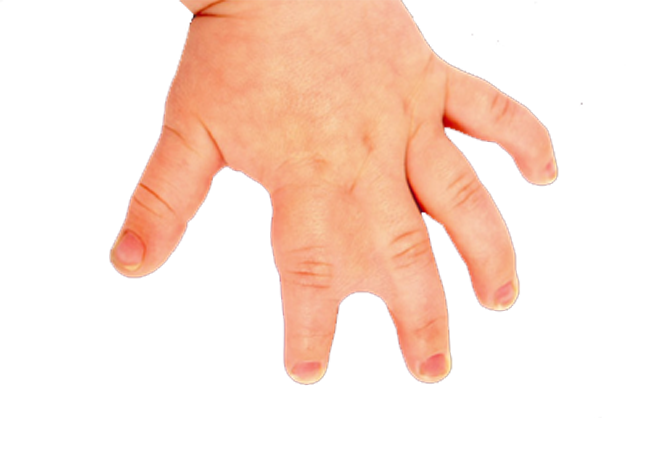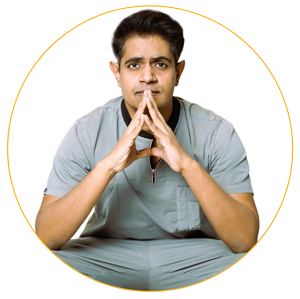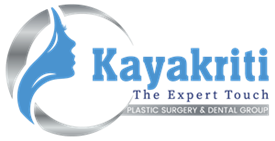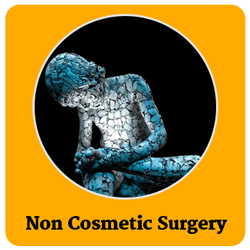Syndactyly
Radial Club Hand
reconstruction
Syndactyly or joined fingers is one of the most common congenital anomalies in the upper extremity.

Best Syndactyly (joined fingers) Treatment in India
Syndactyly or joined fingers is one of the most common congenital anomaly seen in the upper limb in children.
How common is syndactyly in children?
The incidence of syndactyly is 1 in 2000 live birthsand males are more affected than females. About 50% of the children born with syndactylyhave involvement of fingers of the hands. In few cases, toes of the foot are also involved.
What causes syndactyly in children?
During the development of the baby inside the mother, baby's hand is in the shape of a paddle which later splits into individual fingers. The reason for formation of syndactyly is failure of apoptosis (cell absorption) that is needed for separation of fingers.
Syndactyly often runs in families. About 10 to 40 percent of children with syndactyly inherit the condition from a parent.
Which fingers are commonly involved in syndactyly?
The following fingers are involved in decreasing order-
- Middle finger and ring finger
- Ring finger and little finger
- Index finger and middle finger
- Thumb and index finger
Multiple fingers of one hand or both the hands can also be involved.
How is syndactyly diagnosed?
Syndactyly is diagnosed after a child is born with joined or webbed fingers. Though it can be diagnosed prenatally during a level 2 ultrasound.
An Xray is done to rule out any fusion or deformity of the underlying bone.
What are the different types of syndactyly?
- Simple – when fingers are joined by skin and soft tissueonly
- Complex - when along with soft tissue involvement,underlying bones of both the fingers are also fused together.
- Complicated - when along with soft tissue involvementand bone fusion, there is abnormal development of the extra bone and ligaments.
What is the Treatment of syndactyly?
Syndactyly can only be treated with surgery.
- Timing of surgery depends on the fingers involved and whether the type of syndactyly is skin only or with bone fusion
- Simple syndactyly release can be done from 6 months onwards (mostly it can be operated upon between 1-2 years)
- Early surgery prevents asymmetric growth and to create a possibility for grasp in children.
- Early indications for surgery are
- syndactyly between fingers of unequal length and/or
- distal (end of finger) bone fusions and in
- complex or complicated syndactyly especially if the thumb is involved
How is the surgery for syndactyly done at Kayakriti?
Best Treatment of syndactyly is the releaseof both the fingers surgically that means- separation of the conjoined skin and subcutaneous tissues preserving the integrity of the nerve and vessels of the fingers.
- Creation of a web space between fingers,
- Treating the lateral soft - tissue defects- by zigzag skin plasty
- Skin grafting on less demanding parts of the fingers. Full thickness skin graft is mostly used to cover the defect.
- Separation of the fingertips–
- If the nails are separately developed in complete syndactyly, the pulp can be separated and the skin advanced to the margin of the nail.
- If the nails are conjoined, nail wall reconstruction with flaps is necessary. Buck-Gramcko pedicled pulp flaps for nail wall reconstruction from adjacent finger pulp are done for reconstruction.
Recovery after surgery for syndactyly
- During the surgery, paraffin gauze is applied on the wounds and grafts, followed by bandage and a slab.
- The elbow, forearm and hand are subsequently covered with a plaster slab to prevent accidental removal of the dressing by the child.
- The child can be sent home the very next day after the surgery
- 1st dressing is done after 5 to 7 days on OPD basis and then subsequent dressings after every 3 to 4 days.
- Immobilization is advised for 6 weeks
- After that regular physiotherapy is started with night-time splintage religiously for 3 months to prevent contracture.
Know your surgeon better

Best plastic surgeon, Dr. Amit Agarwal is an American Board Certified, extensively trained, and best Plastic & Aesthetic surgeon in Lucknow. He is the Chief Plastic Surgeon heading the Department of Plastic, Microvascular, and Craniofacial surgery at Vivekananda Polyclinic and Institute of Medical Sciences, Lucknow, U.P, India. He maintains a busy practice at Avadh and Nishat Hospital and his own center - Kayakriti Plastic Surgery & Dental Center. He was formerly a Consultant in the Department of Plastic Surgery and Burns at the prestigious SGPGI, Lucknow.
MS, DNB (General Surgery) MCh, DNB (Plastic Surgery),
MNAMS, FACS, FICS, FRCS (Edinburgh, UK)
His Credentials
Three pillars of kayakriti
Privacy
We believe your experience with us should be comfortable and hassle-free to make it one of your best lifetime experiences for yours. We, here at the clinic, take full precautions to maintain your privacy in any manner. We also provide a staff who will receive you from the gate and take you to the chamber directly if you demand.
Trust
Our Surgeon is highly qualified and internationally certified with a team of skilled staff to perform any surgical or non-surgical treatment on your body.
Safety
When you plan to undergo any surgery you should always keep in mind that it's your body and it's a surgery. We, here always keep your safety a priority and will never recommend you to undergo any such procedure which is not safe for you. We also provide you with a detailed description of the complications which may occur after the surgery during the consultation as it's a surgical procedure so there may be some complications depending on the way your body reacts.
Kayakriti in news



Frequently Asked Questions
If you have flat or small breast and you want to improve your breast and hip contour ratio then you are a good candidate for it. The answer will be best provided after the first consultation with Dr Amit Agarwal.
Acute pain will be there for almost a week which gradually reduces and there will be soreness and swelling which may take up to 3 weeks to subside.
You can join your work and daily routines after a week of the procedure and can start exercising after 3 weeks of it.
Yes, you have to wear it round the clock unless we suggest you to remove it.
This surgery does not affect the ducts or the areas of the breast involved in milk production. Thus, it does not affect the breast feeding.
This surgery does not affect the ducts or the areas of the breast involved in milk production. Thus, it does not affect the breast feeding.












Kayakriti Plastic Surgery & Dental Center
D-43, Near Punjab National Bank, Rajajipuram, Lucknow, Uttar Pradesh - 226017, India
Phone No. +919695940009, +919695940006
Map Location





























Social Media Presence